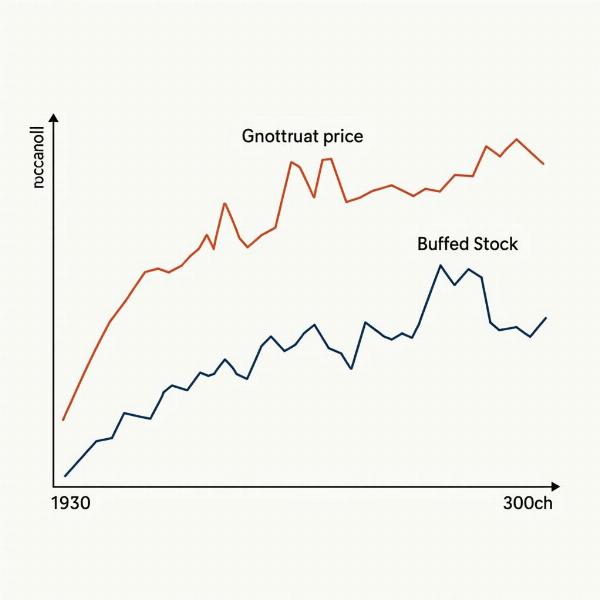Understanding the concept of “buffer stock” is crucial for anyone interested in economics, agriculture, and government policy. In Hindi, buffer stock is known as bhaṇḍāraṇ sthiti (भंडारण स्थिति) or saṃrakshi sthiti (संरक्षी स्थिति). This article will delve into the meaning, purpose, advantages, and disadvantages of buffer stocks, particularly within the Indian context.
What is Buffer Stock? (Buffer Stock Kya Hai?)
Buffer stock refers to a reserve of essential commodities, especially agricultural products like wheat, rice, and pulses, maintained by the government to stabilize prices and ensure food security. These stocks are released into the market during times of shortage or price spikes, preventing drastic fluctuations and protecting consumers from inflated costs. Conversely, during periods of surplus production, the government purchases excess produce to prevent prices from crashing, thus supporting farmers’ incomes.
Why are Buffer Stocks Important in India?
India, with its large population and dependence on agriculture, relies heavily on buffer stocks. They play a crucial role in managing food inflation, particularly during droughts, floods, or other unforeseen circumstances. This system provides a safety net for both consumers and farmers, ensuring food availability at affordable prices and preventing distress sales by farmers.
Advantages of Buffer Stock
- Price Stabilization: Buffer stocks curb excessive price fluctuations, benefiting both consumers and producers.
- Food Security: They guarantee a minimum level of food availability, even during lean periods.
- Support for Farmers: By purchasing excess produce, the government prevents distress sales and ensures fair prices for farmers.
- Disaster Management: Buffer stocks provide crucial support during natural disasters or other emergencies.
 Price Stabilization Chart
Price Stabilization Chart
Disadvantages of Buffer Stock
- Storage Costs: Maintaining large stocks incurs significant warehousing and preservation expenses.
- Wastage: Improper storage can lead to spoilage and wastage of valuable food grains.
- Market Distortion: Government intervention in the market can sometimes distort price signals and discourage private investment.
- Financial Burden: The cost of procuring and maintaining buffer stocks can strain government finances.
How Does the Buffer Stock System Work in India?
The Food Corporation of India (FCI) is the primary agency responsible for managing buffer stocks in India. It procures grains from farmers at Minimum Support Prices (MSP) and stores them in warehouses across the country. The FCI then releases these stocks into the market through the Public Distribution System (PDS) at subsidized rates.
Buffer Stock and Inflation Control
Buffer stocks are a critical tool for controlling food inflation. By releasing stocks into the market during periods of high demand, the government can moderate price increases and ensure affordability. This proactive approach helps to prevent social unrest and maintain economic stability.
Conclusion: Balancing Benefits and Challenges
Buffer stocks play a vital role in India’s food security and economic stability. While they offer significant advantages in terms of price stabilization and support for farmers, they also pose challenges related to storage costs, potential wastage, and market distortion. Effective management and continuous improvement of the buffer stock system are crucial to maximize its benefits and minimize its drawbacks. Finding the right balance between maintaining adequate reserves and avoiding excessive costs is essential for ensuring sustainable food security in India.
FAQ:
- What is the main purpose of a buffer stock? The main purpose is to stabilize prices and ensure food security.
- Who manages buffer stocks in India? The Food Corporation of India (FCI).
- What are the key challenges of maintaining buffer stocks? Storage costs, wastage, and potential market distortion.
- How do buffer stocks help farmers? They prevent distress sales by ensuring a minimum support price.
- What is the role of the PDS in the buffer stock system? The PDS distributes the stocked grains to consumers at subsidized rates.
- Why is buffer stock important for inflation control? It helps moderate price increases by releasing stocks during high demand.
- What is buffer stock called in Hindi? Bhaṇḍāraṇ sthiti (भंडारण स्थिति) or saṃrakshi sthiti (संरक्षी स्थिति).
Meaning-Hindi.in is your trusted partner for professional Hindi translation services. We specialize in a wide range of translation solutions, including business and commercial documents, legal and certified translations, technical manuals, website localization, and educational materials. Our expert team delivers accurate and culturally sensitive translations to help you connect with your target audience. Need help with translation? Contact us today! Email: [email protected], Phone: +91 11-4502-7584 or visit Meaning-Hindi.in.